#shell midden
Explore tagged Tumblr posts
Text
Mesolithic Encounters: Tarradale Shell Midden Excavation, Autumn 2023
by Eric Grant 2023 excavations in Trench 2B In 2017 the Tarradale Through Time project excavated a shell midden (known as site 2B) located on a raised beach terrace at the foot of a palaeo-cliff about 150 m south-east of Tarradale House, see previous blog post. In September to October 2023 the site was revisited by the Tarradale Archaeological Team in order to continue the earlier…

View On WordPress
#antler T axe#antler tine#Archaeological dig#Beauly Firth#boar canine#ecofacts#mesolithic archaeology#NOSAS#paleo-cliff#radiocarbon dates#raised beach#shell midden#shellfish gathering#Tarradale#wet sieving
0 notes
Text
I be like “I know a place” then take you to a small archaeological site where I live to show you the shell middens and petroglyphs
1 note
·
View note
Text










Forest (No. 207)
Whaleback Shell Midden State Historic Site, Damariscotta
#Whaleback Shell Midden State Historic Site#Damariscotta#Maine#vacation#tourist attraction#landmark#summer 2018#landscape#countryside#woods#forest#nature#flora#USA#travel#original photography#river bank#US history#Native American history#meadow#Damariscotta River#New England#East Coast
24 notes
·
View notes
Text

Oyster and Scallop Shells from a Prehistoric Shell Midden, 7500 to 4000 BCE, Isle of Risga, Loch Sunart, The Highlands, Kelvingrove Museum, Glasgow
#ice age#stone age#bronze age#iron age#prehistoric#prehistory#neolithic#mesolithic#paleolithic#archaeology#midden#shells#food#hunter gatherer#tribes#nomadic#food source#waste#scallop#oyster#seafood#coastal
49 notes
·
View notes
Text
preemptively apologizing to grad schools for me being a specific ass person
#mhac.txt#working some on outlining my presentation about my independent study#amidst thinking about the preliminary plan to continue this project next year#i'm a diligent researcher but at what cost (i'm gonna know way too much about shell middens)
2 notes
·
View notes
Photo

Jomon Period
The Jomon Period is the earliest historical era of Japanese history which began around 14500 BCE, coinciding with the Neolithic Period in Europe and Asia, and ended around 300 BCE when the Yayoi Period began. The name Jomon, meaning 'cord marked' or 'patterned', comes from the style of pottery made during that time. Although the entire period is called Jomon, various phases can be identified based on the style and intended use of the pottery.
Settlement & Subsistence
The people that came to what would be known today as Japan first did so near the end of the last glacial period, or Ice Age, most likely while following animal herds over land bridges formed during the glacial period. When the climate warmed and the land bridges disappeared, the soon-to-be Jomon people found themselves on an island. With the animal herds cut off from their homelands dying off, the Jomon people utilized hunting and gathering to fulfil their needs. Their diet has been found to consist of bears, boars, fish, shellfish, yams, wild grapes, walnuts, chestnuts, and acorns. Evidence of their diet was found inside middens, domestic waste disposal piles, and shell mounds that were found near villages.
Starting around 5000 BCE, the Jomon developed a more sedentary lifestyle settling into villages; the largest one at the time covered around 100 acres (c. 0.4 km²) and had about 500 people. Villages near the sea would have relied heavily on fishing while settlements further inland adopted a primarily hunting lifestyle. In many villages, what are assumed to be ceremonial stone platforms and storage pits have been found. The initial simple shelters of the villages would soon develop into pithouses built around a central fireplace, with a structure supported by pillars, accommodating around five people each. The Jomon people would settle in different areas depending on the changing climate; colder periods would require proximity to the sea as evidenced by much larger mounds of shells and fish bones found compared to warmer periods when the settlement pattern shows a shift to further inland sites in order to take advantage of the flourishing flora and fauna.
Along with the change in habitation, the total population underwent significant fluctuation: by 5000 BCE the population would grow from 20,000 to 100,000, only to grow further to 200,000 by 3000 BCE before falling back to 100,000 by the end of the period. Although the Jomon people had a somewhat sedentary life, the agricultural revolution only came with the introduction of rice farming near the end of the Jomon Period. This was around 900 BCE when along with advanced metalworking techniques rice was brought to southwestern Japan from what is today Korea.
Continue reading...
106 notes
·
View notes
Text
The early colonists saw the oyster middens on this section of the shore at Warrane (Sydney Harbour). As they only knew of cockle shells, they called it Cockle Bay.
Quite a different place now, and sparkling on a cloudy dawn.

35 notes
·
View notes
Text
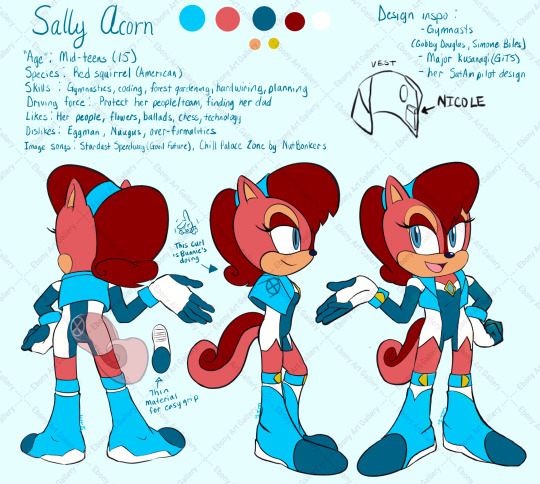


Slight update to my Sally Acorn design.
This sure grew out of control! Following what I know of Sega and their character requirements is an interesting art challenge, gotta say. Stat details for readability:
Stats:
"Age": Mid-teens (15)
Species: Red squirrel (American)
Skills: Gymnastics, coding, forest gardening, hardwiring, planning
Driving force: Protect her people/team, finding her dad
Likes: Her people, flowers, ballads, chess, technology
Dislikes: Eggman, Naugus, over-formalities, [being underestimated especially when it comes to her skills]
Image songs: Stardust Speedway (Good Future), Chill Palace Zone by NutBonkers
Design Inspo: Gymnasts (Gabby Douglas, Simone Biles), Major Kusanagi (Ghost in the Shell), her SatAm pilot design
Ranks I just made up: Speed: B [she's as fast as every other character who's not Sonic or Shadow] Power: C [she can lift one person, slowly push a large rock...] Skill: S [she's a fast learner, especially when it comes to tech and a brilliant strategist who's gotten better at thinking on the fly] Flight: N/A
Game play:
uses "Midden system", originally created [by Rotor, NICOLE, and herself] for salvaging and storage.
when the Midden system is activated, the arrows on her outfit glow cyan
names attacks after chess moves/tech terms
"Caches" items to use later on
asks NICOLE to "scan" items
can cling to many surfaces (she’s a squirrel lol)
Homing attack (“Castling”): jumps to take over robot enemies, only temporary, robot explodes after use.
Counter/parry (“Counter gambit”): she forms an orb of coding to throw at enemy projectiles (think Kirby’s star bullet), can be done while running, a high risk/high reward for stronger enemies.
Spin attack (“Shadow tail spin”): not a 1 shot, take 3 hits to be effective
Sync: calls on friends via NICOLE for specific jobs, only 3 friends can be picked before levels.
#sonic the hedgehog#sonic satam#sally acorn#freedom fighters#archie sonic#tho i was avoiding a lot of archie stuff due to the challenge#character designs#digital art#procreate
47 notes
·
View notes
Text
Çatalhöyük and the Beginning of Cities
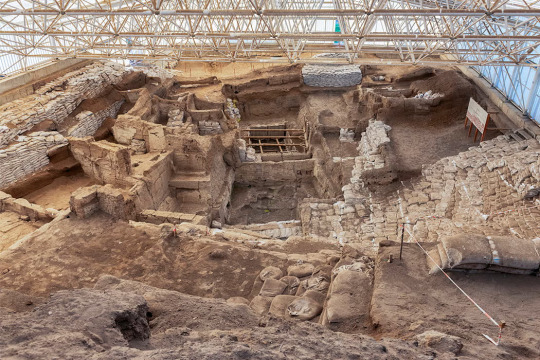
Source: https://daily.jstor.org/catalhoyuk-its-story-continues/
Çatalhöyük is a site in Türkiye that captures the transition between small groups of hunter-gatherers following food sources to a more settled lifestyle that changed the land around it to raise crops and herds of animals. As we have studied it over the past half century, we have learned a lot about the first city that housed about 8,000 people at its highest. Our perspectives have also shifted, as well, from a perspective rooted in a matriarchal society to one in which gender wasn't destiny.

By Nevit Dilmen (talk) - Own work, CC BY-SA 3.0, https://commons.wikimedia.org/w/index.php?curid=14783156
Within Çatalhöyük, houses shared walls and there weren't any streets to separate them. People walked from roof to roof to travel through the city and homes were entered through the roofs, as well, via a ladder. Homes show evidence of being plastered and decorated with murals and figurines. Among these figurines were initially found quite a lot of Venus figurines, 'voluptuous, nude women', which led early researchers to hypothesize that there was a matriarchal society worshiping a 'mother goddess', which gained traction at the time as it was in the middle of the rise of second wave feminism. Within this 'matriarchal society', it was thought that women controlled economic factors and were the ones who directed religious life.

By Wolfgang Sauber - Own work, CC BY-SA 4.0, https://commons.wikimedia.org/w/index.php?curid=53242123
Further research pushed back against this idea, proposing that if it were true, there should be a stratification visible in the remains at Çatalhöyük, but what is found is a relatively equal distribution of goods as well as a lot of shrines without the separation of a 'priestly quarter'. Additionally, with a much larger quantity of figures found, only 5% represented the 'mother goddess' style. Later cities that had a documented hierarchy showed a clustering of goods and shrines. The site also seems to lack public buildings, based on the sizes of the buildings and rooms within them, which would be needed for a socially segregated society. Instead, the way the buildings are clustered together indicate a society that was more cooperative. It is possible that the roofs themselves formed the public 'building', lending a place to gather together, especially when the weather was nice.
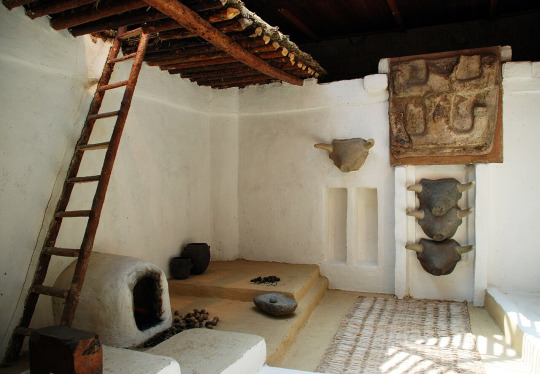
By Elelicht - Own work, CC BY-SA 3.0, https://commons.wikimedia.org/w/index.php?curid=22743701
The houses had plastered walls and floors and were kept very clean, as there is very little rubbish remaining in them as archaeologists study the site. Refuse of all kinds was taken to midden heaps outside the ruins. Burials, though, happened under the floors of the homes, especially under the hearths. People were usually buried tightly curled up into the fetal position then put into baskets or wrapped into reed mats. There is also some evidence that people were exposed before their burial. Supporting the belief of an egalitarian society, these burials show that males and females enjoyed equal nutrition and were equally treated in death.
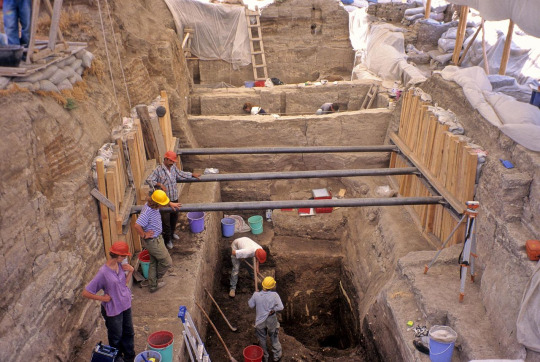
By Mark Nesbitt from London - 017-nesbitt, CC BY 2.0, https://commons.wikimedia.org/w/index.php?curid=7429579
Çatalhöyük shows at least 18 levels of rebuilding, showing that it was used over a long period of time and the individual houses also show renovation within them. Each layer was built of mud brick and then plastered over. It was in use between approximately 7100 and 5700 BCE. Within the remains, we can find the beginnings of agriculture with crops such as wheat, barley, and peas. Evidence of animal domestication can also be found with the bones of sheep and, later, cattle being found. The remains of pottery and obsidian tools can be found as well as evidence of trading with shells from the Mediterranean and flint from Syria.
5 notes
·
View notes
Text






We got to play marsh trolls this afternoon. The marsh was as dry as I’ve seen it. Even with the full moon and extra high tides.
The last picture is an old shell midden. They are all over the Lowcountry. They can be anywhere from a few hundred to a few thousand years old. The little island we are standing on is basically one big midden. Someone has dug into this midden recently. Most likely looking for artifacts. Which is pretty shitty, imho.
I’m not sure the dead do anything other than stay dead. The only thing they have is what they left behind, what they created, what we can see. And, with respect and reverence, what we can touch. I get a little pissed when people just shit on that like some fucking troglodyte
5 notes
·
View notes
Text
Fandom: tmnt, no particular continuity
Prompt: Came Back Wrong
Notes: This is a tgcf crossover, which is where it borrows the lore on ghosts from.
-
There have been reports of ghosts, terrible green creatures that perch like gargoyles on the roof of the house and terrify anyone using the outhouse. The cultivator listens to the words of the woman who lives here and the interjections of her children, who seem to see the creatures most often, and nods.
“You say they were scaled? Did they have shells?”
The children don’t know. Only that they had terrible white eyes that gleamed in the night.
The cultivator turns to the mother. “Did you have turtle soup lately?”
“Yes, a few weeks ago. My husband caught the turtles down by the lake,” she says, surprised.
“And these ghosts have appeared since then?”
“Yes… You think they are turtles?”
“It’s not unheard of, “ the cultivator answers, “for animals to resent being eaten. Did you keep any of the remains? The shells?”
“No, they were soft shelled. I threw the bones and shells onto the midden.”
“Then I shall dig them out.”
It is not what most people would call a pleasant task but the cultivator doesn’t mind. It reminds him of his youth, in a way, giving him a chance to reflect on how different his life is now. There was a time when meat stripped from the bones of yesterday’s chicken might have given him a good meal. Today he is after something else.
It is a pitiful collection, four shells with the leathery hide mostly rotten away to show the delicate spurs of bone sticking out of the central carapace, and a little pile of bones that are beyond sorting. Young turtles, he thinks, which explains the ghosts. The young can be passionate, even reptiles.
The cultivator holds his hand out over the bones and says a blessing before channeling spiritual power into a white hot flame. The children who had been giggling as he picked through the trash and blessed the remains of their meal stop to look at him in awe. However, they do not have the patience to wait the time it takes to reduce bones to ash.
By the time he is done night has fallen and, when he looks up, eight white eyes look back at him from the darkness.
“Welcome to this place. I would speak with you,” he tells them gently.
They move closer. In the moonlight he can see their shells, the three-fingered hands. After death human ghosts can take on partially animal forms and animal ghosts can take on partially human forms, but they must be powerful to have done this so quickly.
“You have changed a lot in a short time,” he says.
“You’re telling us,” one of them mutters.
Another makes an awkward bob with its head and the cultivator thinks, this one wants to be polite but does not know how. “Will you disperse us?” it asks.
“Do you want me to?” he asks.
They chorus “no”, holding onto one another. Perhaps they would be better off at peace, but he does not have it in him to destroy them by force.
“Then I will not. You seem to have been quite restrained. Other ghosts in your place have tried to eat the humans that ate them, the worst you’ve done is scare them.”
“We don’t really want to hurt anyone,” says the smallest turtle. “It was just funny to see them run.”
Fear and confusion seem to have formed them more than aggression, although there almost certainly is anger for them to be this powerful.
“If you’re not going to disperse us can we have our ashes?” the same turtle who asked if he would disperse them continues.
“Will you promise to leave this place?”
“But where will we go?” asks the turtle who hasn’t spoken yet. “Back to the lake?”
The lake was likely their whole world and the fishermen of the village certainly won’t welcome them there now. The cultivator considers. “Perhaps, after I give you your ashes, you could come with me?”
“With a human?” snaps one of them, and, ah, there’s the anger.
“Not quite,” the cultivator answers, and lets go of his form, returning to the scruffy brown rat that is his natural form. A long time ago a cultivator had made a beloved companion of him, carrying him on his shoulder and talking to him of the arts he studied. Since then the rat has studied on his own. “My human form is cultivated, as you see. Perhaps I could help you become accustomed to your new forms as well.”
He steps back to let them divide the ashes among them, mixed as they are, while they consider. For now he stays in this, less threatening, form.
When they are done the turtles turn to him. “We’ll come with you. But where will you take us?”
“Ghost City, I think. It is a rough place, but people will not fear you there.” Nor, he adds to himself, will you be tempted by revenge in a place with few humans. But they do not strike him as vengeful. Perhaps, in a place where they can be accepted, even a place with few morals, he can teach them to do some good.
14 notes
·
View notes
Text
question: what soul do you possess? answer: a dominating soul.
not even a grave could hold your body down. it would crawl right out of the dirt. the omnipresence of simply just your being is overwhelming in an awestruck way. you may not even realise it but people aren't just afraid of you. they look up to you. but the journey to the top is a lonely one. and you ache for a companion. you ache to let yourself feel soft for once. to take off the metal helm and let yourself breathe. let the wind flow through your hair and kiss your cheeks. hopelessly gooey in the middle. but don't be fooled. don't let your leering power, your steel outer shell make you be above others. do not let it fester unchecked and create an ego too big for your mortal body. reality check yourself every now and then, it couldn't hurt. or it might.
tagged by: @satellitewar thank you mwah < 3 tagging: @chanticle @fadedmemoria @drekr @middener @crowspoise + you, who is reading this hehe
2 notes
·
View notes
Text






























Maine became the 23rd U.S. state on March 15, 1820.
#205th anniversary#US history#architecture#landmark#cityscape#tourist attraction#original photography#summer 2018#Estcourt Station#Acadia National Park#Maine#23rd US State#15 March 1820#landscape#seascape#Atlantic Ocean#travel#vacation#Basilica of Saints Peter and Paul#Lewiston#Whaleback Shell Midden State Historic Site#Damariscotta#Auburn#Androscoggin River#Cape Neddick Point#Stephen King House#Bangor#Lake Winnecook#Penobscot Narrows Bridge#USA
14 notes
·
View notes
Text


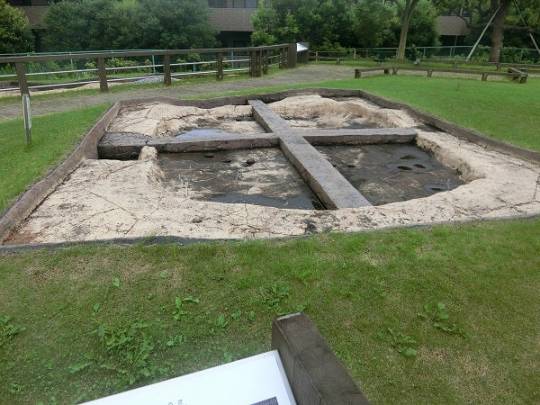


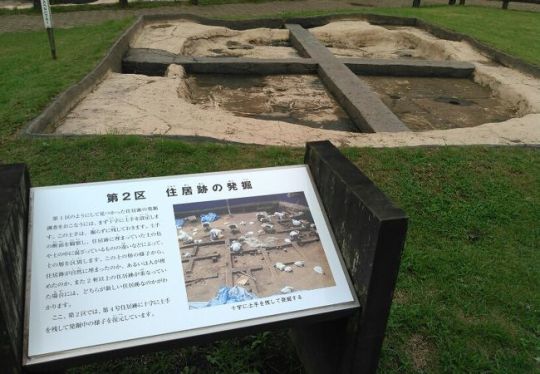
Sean bienvenidos japonistasarqueológicos, a una nueva entrega de arqueología japonesa, una vez dicho esto pónganse cómodos que empezamos. - En esta ocasión nos trasladamos: Al Museo del Parque Histórico Tobinodaique se localiza en la ciudad de Funabashi, prefectura de Chiba,los restos arqueológicos son del periodo Jomon y hay una 200 aproximadamente, en lo que respecta a las ruinas. Además las ruinas de Tobinodai tienen unos 8.000 años de antigüedad y son del período temprano.¿Conocían este yacimiento? - Espero que os haya gustado y nos vemos en próximas publicaciones, que pasen una buena semana. - 日本の考古学者たちよ、ようこそ。そう言われたら、くつろいで、さっそく始めましょう。 - 今回は移動します: 飛ノ台歴史公園博物館へ 千葉県船橋市にある飛ノ台歴史公園博物館は、縄文時代の遺跡で、遺跡としては約200件あります。 また、飛ノ台遺跡は約8,000年前の前期遺跡である。 - 気に入っていただけたでしょうか、また今後の記事でお会いしましょう、良い一週間をお過ごしください。 - Welcome, Japanese archaeologists, to a new installment of Japanese archaeology, and once that's been said, make yourselves comfortable and let's get started. - This time we move on: To the Tobinodaique Historical Park Museum is located in Funabashi City, Chiba Prefecture, the archaeological remains are from the Jomon period and there are about 200 of them, as far as ruins are concerned. In addition, the ruins of Tobinodai are about 8,000 years old and date back to the early period. - I hope you liked it and see you in future posts, have a nice week. Sources: Images owned by the museum Museum:Hinodai Shell Midden Museum. 出典:博物館所蔵の画像 博物館:日野台貝塚資料館
#日本#先史時代#旧石器時代#飛ノ台遺跡#縄文時代早期#船橋市#千葉県#考古学#ウネスコ#遺跡#-#japan#prehistory#paleolithic#tobinodairuins#earlyJomonperiod#Funabashicity#Chibaprefecture#archaeology#unesco#archaeologicalsite
14 notes
·
View notes
Text
he talks about the completely different coastlines now from thousands of years ago. and its soo true!!! a lot of sites may have been lost (although, we can now use LIDAR to look under the ocean in some sites, it has been used in florida to see shell middens and some other cultural remains a ways away from the coast). my professor even studied and found a site she was looking for that, when comparing modern to ancient maps, wasnt there. thats cause the coast changed! its so amazing she found it. gh just doesnt acknowledge this
2 notes
·
View notes
Text
Famous Five Art Nostalgia #18 – Part 1
Introductory post
Masterpost
⛏️💎🗡️ Five on Finniston Farm – Le Club des Cinq et le coffre aux merveilles
Original publication date: 1960 (UK), 1962 (France)

(Original cover art by Jeanne Hives, 1962)
There's not a lot to say about this book whose plot is rather straightforward but which does contain some nice character moments.
It's also the ONLY book from the original editions --illustrated by Baudouin, Durand, Amicis and Hives-- that I don't own a physical copy of 😬 (yet?) Not true anymore 😊
The French title translates to "Famous Five and the Coffer/Chest/Trunk of Wonders." Enjoy!
~~~~~~
Plot summary (adapted from Wikipedia):
The Famous Five spend their summer holidays at Finniston Farm [la ferme des Trois-Pignons] as paying guests. Upon arrival, they are greeted by the pleasant Mrs Philpot [Mme Bonnard] and her identical twins, Henry [Daniel] and Harriet [Danièle], jointly known as “the Harries” [les Daniels*]. The twins seem to take an instant dislike to the Five.
[* Note: It never occurred to me when I first read this book as a kid, but the twins’ having essentially the same name – the only distinction being the male and female variants – is really stupid. Who agreed to name the kids this way at birth??! The English version, featuring Henry and Harriet, is marginally more sensible.]
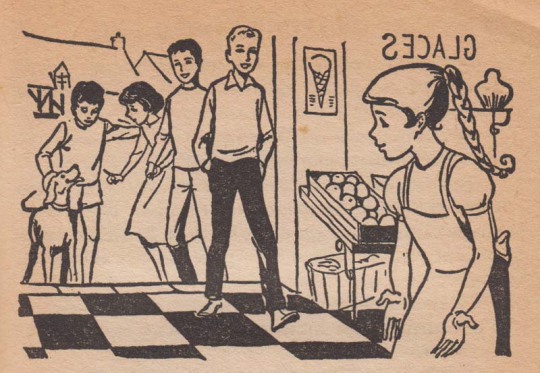
(A refreshing halt for ice creams at the local café 🍧)
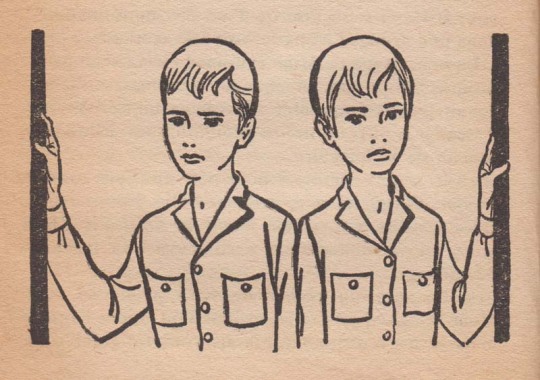
(The surly Harries)
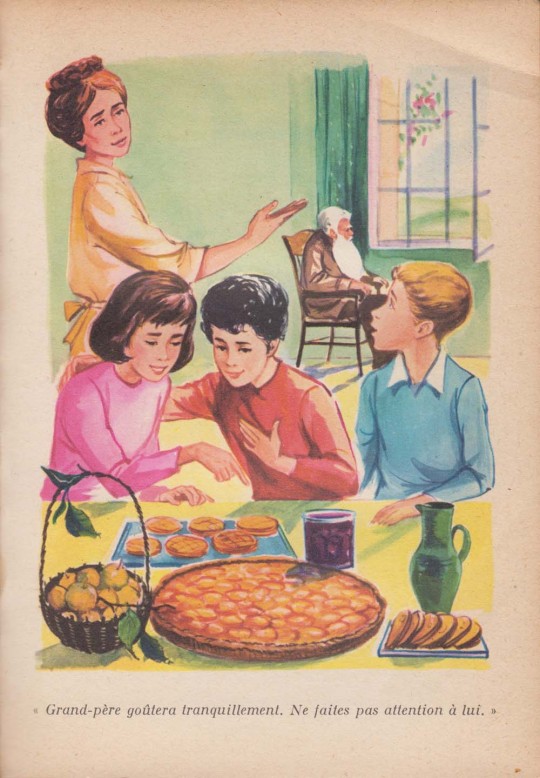
(An appetising welcome at the farm!)
The Five also meet two fellow paying guests: an American, Mr Henning, and his son, Junior [these characters are also American in the French version, and thus keep the same names]. Mr Henning plans to buy antique pieces from the farm and sell them in America. Mr and Mrs Philpot agree to sell their farm treasures as they need the money. However the family's hot-tempered Great-Grandad feels the antiques should remain in England [France].
Mr Henning and Junior prove themselves a nuisance to the household by rudely ordering around Mrs Philpot. Sympathetic to Mrs Philpot, the Five offer to help with farm chores. When Junior demands breakfast in bed, George teaches him a lesson, making him agree to not slave Mrs Philpot thereafter. This wins the hearts of the Harries and they make friends with the Five.

(As part of their chores, the boys help with milking the cows) [Note: I don’t know why Julian looks so smug here, because the text states that Dick has better success due to the cows’ liking his singing voice!]

(Dick gets his watch stolen by Nosey, the twins’ cheeky pet jackdaw!)
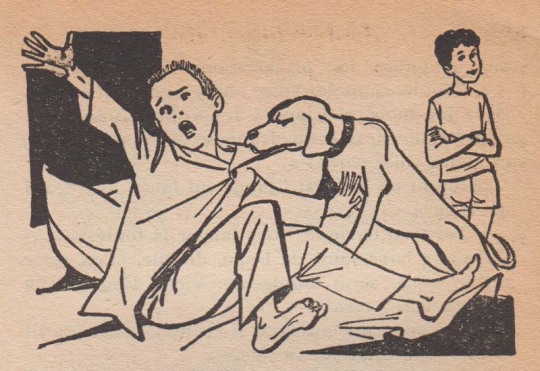
(Junior’s wake-up service is a tad too forceful for his taste)
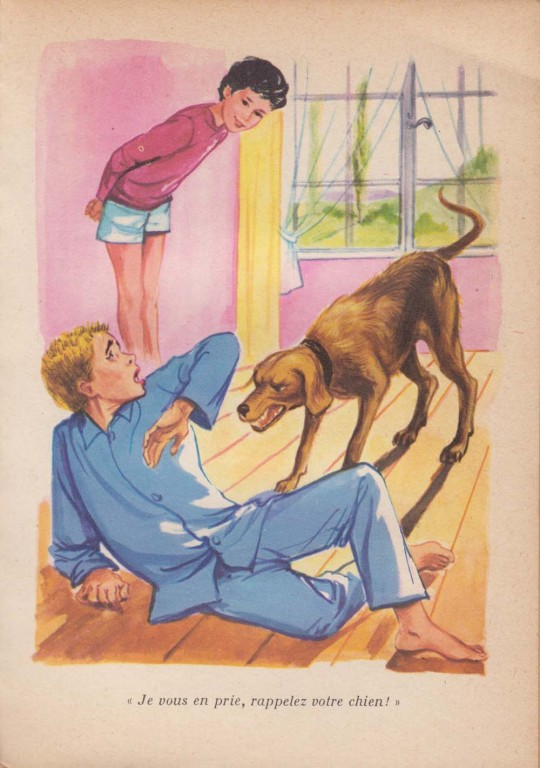
(Five-star service, no complaints accepted, no refunds!)

(Meet the twins’ pets: Snippet the poodle [Friquet le caniche] and Nosey the jackdaw [Zoé la pie])
Anne and George visit a nearby antique shop, owned by a Mr Finniston [M. Francville], who tells them about a secret passage from Finniston Castle to an old chapel and cellars where royal treasure might be hidden.
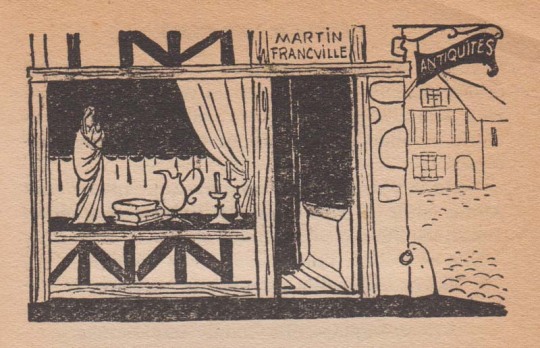
(Mr Finniston’s shop…)

(…and Mr Finniston himself)
The girls excitedly reveal the news to the boys and the twins. Together, they plan to hunt for the cellars on the farm.
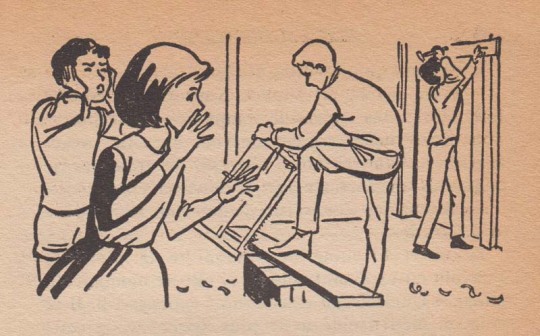
(The girls come to tell the boys what they have learned at the antique shop; meanwhile, the boys have been busy helping with small work around the farm 🔨)

(The twins, like the Five, are very interested in the story about the old castle)
They come across the castle's kitchen-midden* and realise they are close to finding the treasure.
[* Per Julian’s words: “‘A kitchen-midden is what you might call the rubbish-heap of the old days,’ explained Julian picking up some oyster shells. ‘It was often very big, when it comprised the rubbish thrown out from large houses – or castles! Things like bones and shells wouldn’t rot away like other rubbish – and I do believe we’ve found the kitchen-midden of the old castle.’”
In the translated version, Julian/François uses the Danish word for it: “kjœkkenmœdding” (that's a mouthful!), adding that they learned about it from their history teacher recently. A French word exists for it (“amas coquillier”), but the Danish word is apparently more widely used by archaeologists: « C’est un terme archéologique pour désigner les dépôts d’ordures des temps anciens, expliqua François en ramassant quelques débris. Notre professeur d’histoire nous en a parlé juste avant les vacances. C’était un grand trou où l’on enfouissait les détritus des maisons ou des châteaux forts. Les os et les poteries ne pourrissent pas comme le reste ; je crois que nous avons trouvé le kjœkkenmœdding du château de Francville. »]
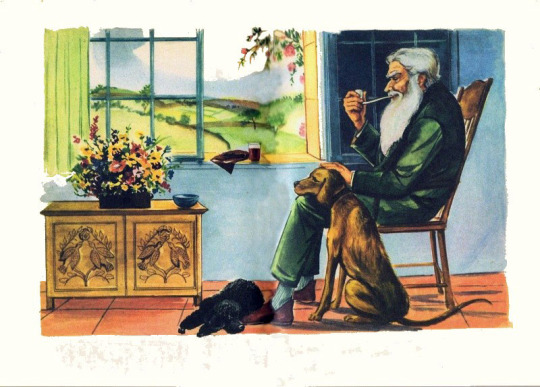
(I’ll just quote the book for this doggie-bliss scene: “Snippet, who had run in fright to the twins as soon as Great-Grandad had begun to shout, ran back to him, and settled on his feet. Timmy also decided to join them, and soon Great-Grandad was completely happy again, drawing on his old pipe, with one dog at his feet, the other resting a great head on his knee.” / « Friquet qui, effrayé par les cris, s’était réfugié à côté des jumeaux, retourna à sa place accoutumée. Dagobert le rejoignit. Le grand-père était maintenant l’image du bonheur, tirant sur sa vieille pipe, un chien à ses pieds et caressant la grosse tête que l’autre avait posée sur ses genoux. »)
Junior spies on the Five and the twins, and rushes to break the news to his father and his father's friend Mr Durleston, who decide to excavate the castle site, find the fortune and sell the goods in America. Mr and Mrs Philpot consent to the excavation, much to the dismay of the children. The children dig around the site, hoping to beat the men in finding the treasure. Initially they are unsuccessful but Snippet and Nosey lead them to a burrow, beneath which the secret passage stretches out. The children discover the cellars and the treasure, only to become trapped inside the tunnel when the entrance caves in.
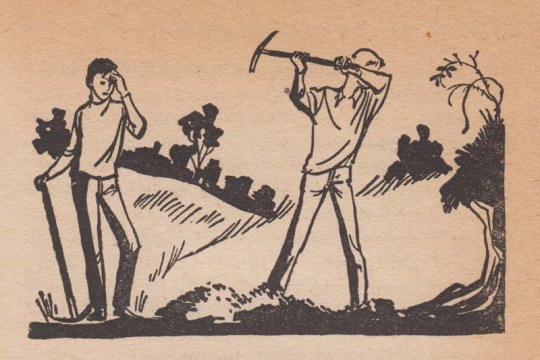
(Two boys hard at work! ⛏️)

(The treasure 😮)

(Crawling underground…)
They take another way and reach a trapdoor under the old chapel, which is now used as a storehouse. The farmhands Bill [Roger] and Jamie [Maurice] hear their shouts and let them out. The children get back to the farm and tell their exciting story to the astonished adults. The next day, Mr Henning and Mr Durleston try to trick the Philpots into believing the site has no treasure and offer them a meagre amount. However, Mr Philpot, backed up by his Grandad and Mr Finniston, declines the offer, making it clear they will excavate the site themselves and no longer want the Americans to stay.

(Great-Grandad has found a new lease of life! 🗡️)
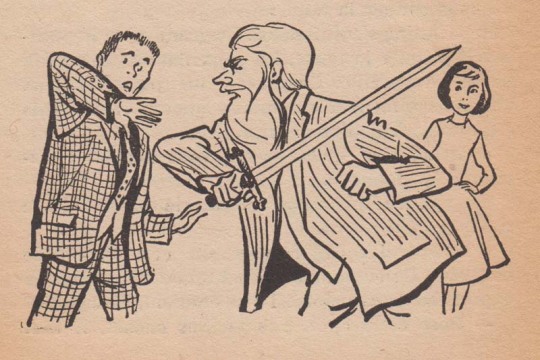
(Great-Grandad tells Mr Henning in no uncertain terms what he can do with himself! 😤)
The adventure ends with the Five planning to stay at the farm to observe the excavation of the treasure.
~~~~~~
Cover art through the ages:
(Disclaimer: This is not an exhaustive list; sometimes the dates are difficult to pinpoint; and I have purposefully not included editions that re-used similar cover art, with differences only in layout and font style.)

(Original cover art by Jeanne Hives, Hachette, 1963) [Note: All of the cover artists depicted the titular “coffer of wonders”, and I’m only going to make a caption when there is something specific to say.]
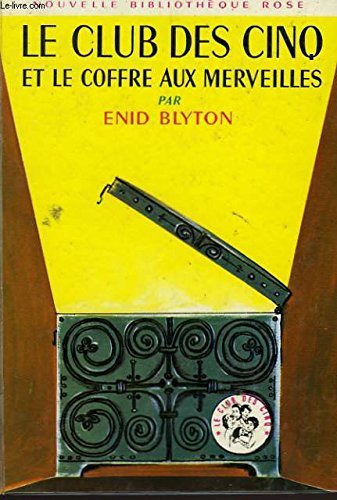
(Subsequent cover art by Jeanne Hives, Hachette, 1968)
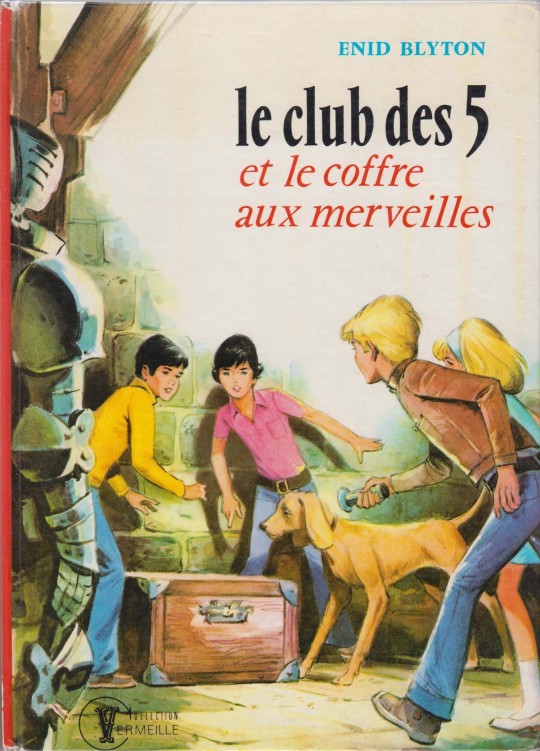
(Jean Sidobre, Hachette, 1973)

(J.P. Morvan, France Loisirs, 1974)
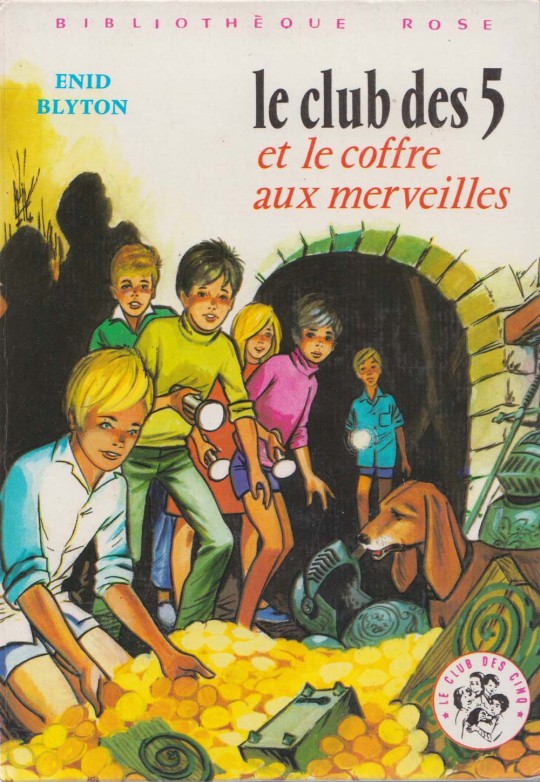
(Jean Sidobre, Hachette, 1979 (based on earlier art))

(Umberto Nonna, Edito Service, 1981)
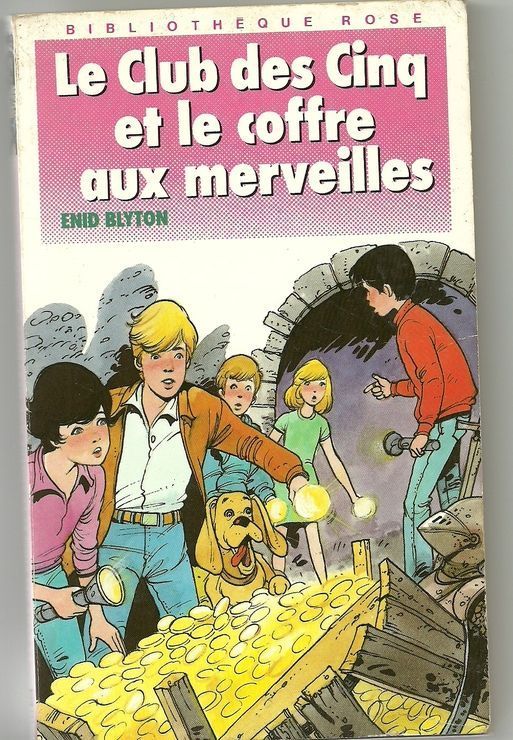
(Yves Beaujard, Hachette, 1988)
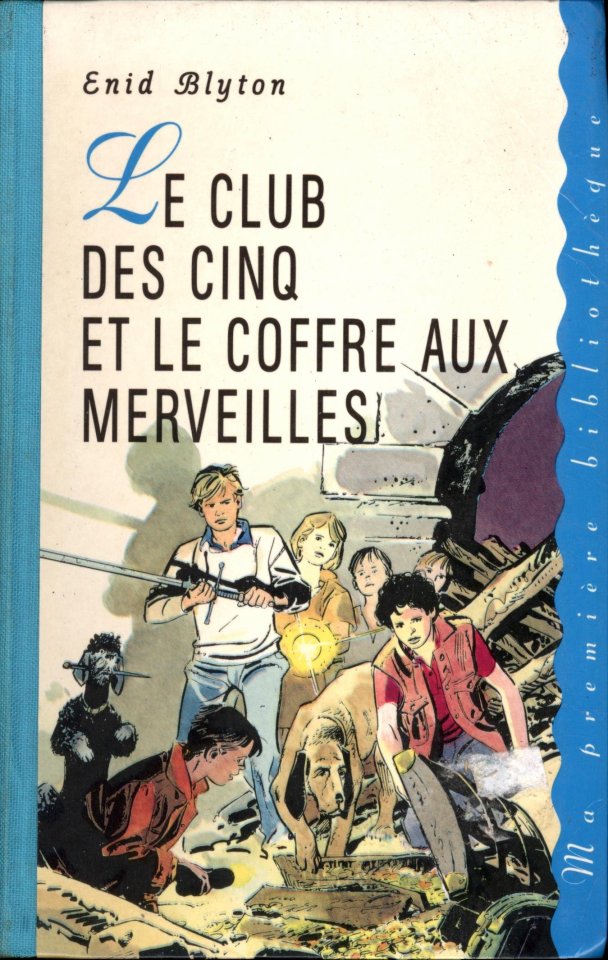
(Paul Gillon, France Loisirs, 1994) [Julian wielding a sword like a knight of old… yes please! 😏]
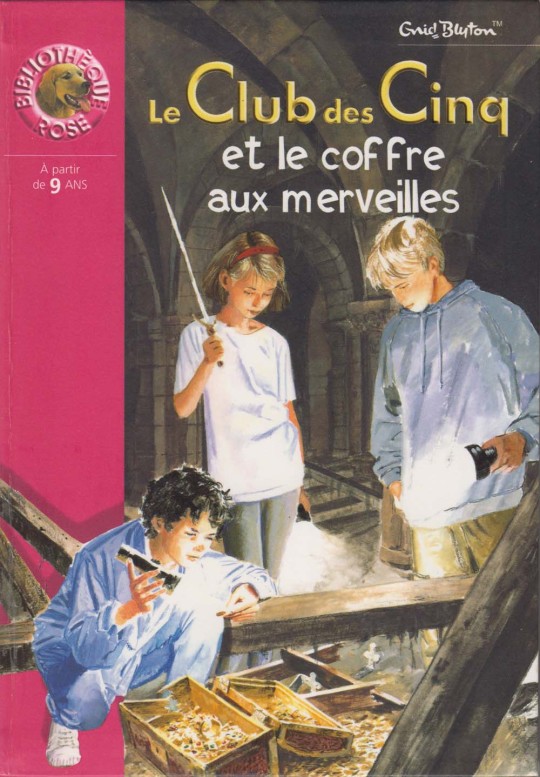
(Munch and Prunier, Hachette, 1999) […Alternatively, I could also go for Anne wielding a sword!]

(Frédéric Rébéna, Hachette, 2008) [It looks that there’s a hypnotic beacon in this trunk, and only Timmy is immune and worried about it 😵💫]
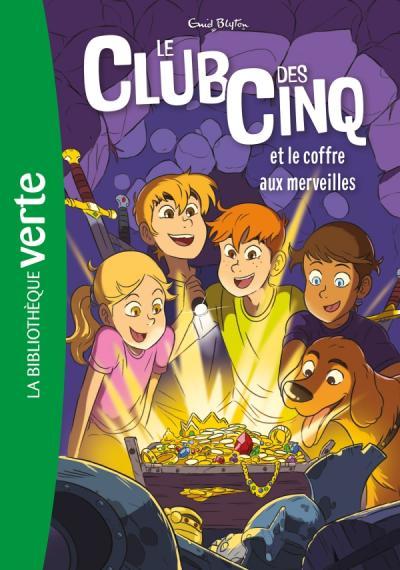
(Auren, Hachette, 2020)
~~~~~~
Thanks for reading!
#papillon82 reads#famous five art nostalgia#famous five#le club des cinq#enid blyton#illustrations#jeanne hives
5 notes
·
View notes